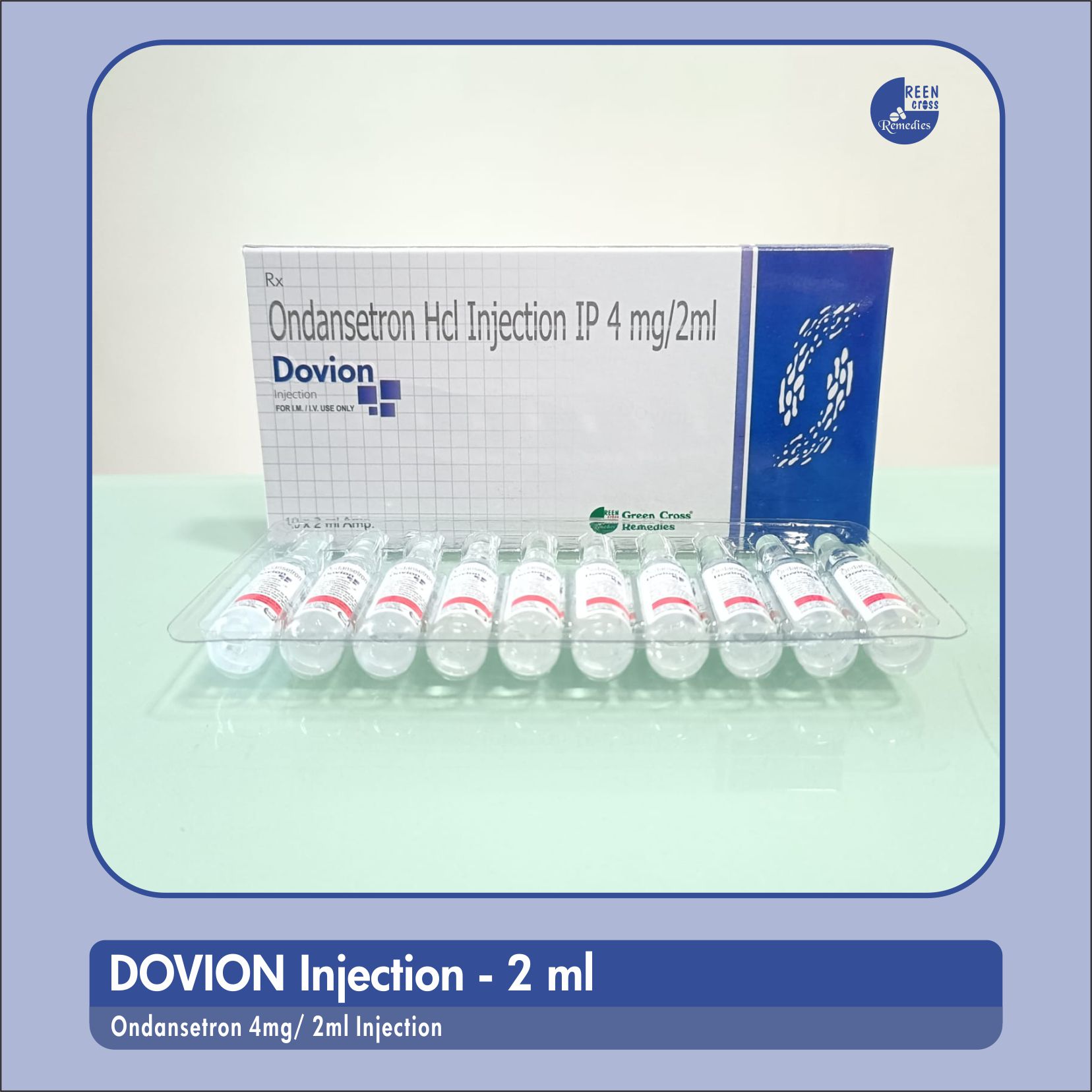DOVION Injection

Ondansetron 2 mg / 1ml (2 ml) Injection Use, Indication, Side Effects, Dosage, Mechanism of Action, Price, Contra-Indications, Drug Interactions...
DOVION Injection
Protects from nausea and vomiting
Use of DOVION Injection:
Ondansetron is an antiemetic medication primarily used to prevent and treat nausea and vomiting. It is commonly administered in cases of:
-
Chemotherapy-induced nausea and vomiting (CINV).
-
Radiation-induced nausea and vomiting.
-
Postoperative nausea and vomiting (PONV).
-
Nausea and vomiting caused by other medical conditions or treatments.
Indications of Ondansetron Injection:
-
Cancer treatment-related nausea: To prevent nausea and vomiting caused by chemotherapy or radiotherapy.
-
Post-surgery nausea: For patients experiencing or at risk of nausea and vomiting following surgery.
-
anesthesia
-
G.I infections
-
Radiotherapy
-
Gastric dysmotality
-
Morning sickness
Side Effects of DOVION Injection:
Common side effects include:
-
Headache.
-
Fatigue or malaise.
-
Dizziness.
-
Constipation.
-
Diarrhea.
Less common but serious side effects: -
Prolonged QT interval (may lead to arrhythmias like Torsades de Pointes).
-
Allergic reactions (rash, itching, or swelling).
-
Blurred vision or temporary blindness (rarely after IV use).
Dosage of Ondansetron Injection:
Dosage varies depending on the indication:
-
Chemotherapy-Induced Nausea and Vomiting (CINV):
Adults: 8 mg administered intravenously or orally 30 minutes before chemotherapy. -
Postoperative Nausea and Vomiting (PONV):
Adults: 4 mg administered intravenously as a single dose just before anesthesia or surgery. -
Pediatric dose: Depends on the child’s weight and condition. Always follow the doctor’s guidance.
Note: Maximum daily dose should not exceed 16 mg intravenously due to the risk of QT prolongation.
Mechanism of Action of DOVION Injection:
Ondansetron works by antagonizing 5-HT3 (serotonin) receptors in both the central nervous system (in the chemoreceptor trigger zone) and the gastrointestinal tract. This blocks the action of serotonin, a major trigger for nausea and vomiting.
Contraindications of Ondansetron Injection:
-
Hypersensitivity or allergy to Ondansetron or any of its components.
-
Congenital long QT syndrome.
-
Concurrent use with apomorphine (risk of severe hypotension and loss of consciousness).
Drug Interactions of DOVION Injection:
-
QT-Prolonging Drugs: Combining Ondansetron with medications like amiodarone or sotalol increases the risk of QT prolongation.
-
CYP3A4 Inducers/Inhibitors: Drugs that affect liver enzymes (e.g., phenytoin, carbamazepine, or rifampin) may reduce Ondansetron's efficacy.
-
Serotonergic Drugs: Increased risk of serotonin syndrome when combined with SSRIs, SNRIs, or MAO inhibitors.
-
Tramadol: Ondansetron may reduce the analgesic effect of tramadol.
Precautions of Ondansetron Injection:
-
Use with caution in patients with electrolyte imbalances (e.g., hypokalemia or hypomagnesemia).
-
Monitor ECG in patients at risk of QT prolongation.
-
Safe for use in pregnancy only if clearly indicated (Category B).
For proper use and safety, always consult a healthcare professional before starting Ondansetron.
For Use of Registered Medical Practitioner or A Hospital Only

